The Spanish translation of this essay follows its original English text.
From the outset, Commonwealth—a group exhibition at the Institute of Contemporary Art at Virginia Commonwealth University in Richmond—is an exercise in contradiction. Just outside the building’s entrance, an expansive urban garden created for the exhibition by food justice activist Duron Chavis and designer Quilian Riano celebrates Black life and the necessity of inclusive space through garden beds overlayed with images and quotes from Assata Shakur, Audre Lorde, and other Black activists and intellectuals. A nearby mural spanning both a wall and the pavement below declares BLACK SPACE MATTERS, echoing the street murals that appeared in cities across the country this summer. And then, just beyond the garden, a swath of graffiti spreads across the building’s titanium exterior. Despite attempts to remove the tags, you can easily make out the messages: BLM, Fuck 12, and, notably, Fuck VCU and VCU doesn’t care BLM. Next to these messages, a pair of security cameras observes the area.
The parallel, conflicting statements here are arresting: on one hand, we find an admirable artistic intervention, commissioned by a powerful institution, acknowledging systemic disparities and chipping away at food insecurity (the produce harvested from the garden is donated to VCU’s on-campus food pantry for students in need). On the other hand, we find a firm condemnation of that same institution for otherwise failing to reflect those same values.
The graffiti came during protests that erupted in Richmond following the murders of George Floyd and Breonna Taylor by police. They are also evidence of the criticism leveled against VCU following the university president’s reaction to the uprising. In July, one day after police tear-gassed protestors and arrested several demonstrators—among them VCU students and members of VCU’s Student Government Association (SGA)—the university’s president, Michael Rao, released a statement denouncing a purported $100,000 in damage to VCU property sustained during a boiling point in the protests, while also claiming solidarity with the cause. The SGA promptly responded to Rao’s statement, asserting that the university “prioritizes profit and image over the wellbeing of students.” President Rao’s inconsistent declaration of solidarity and intimation of fear toward protestors is reflected on Richmond’s streets: many of the storefront windows lining the city’s commercial districts are sealed by both protective plywood and Black Lives Matter signs.
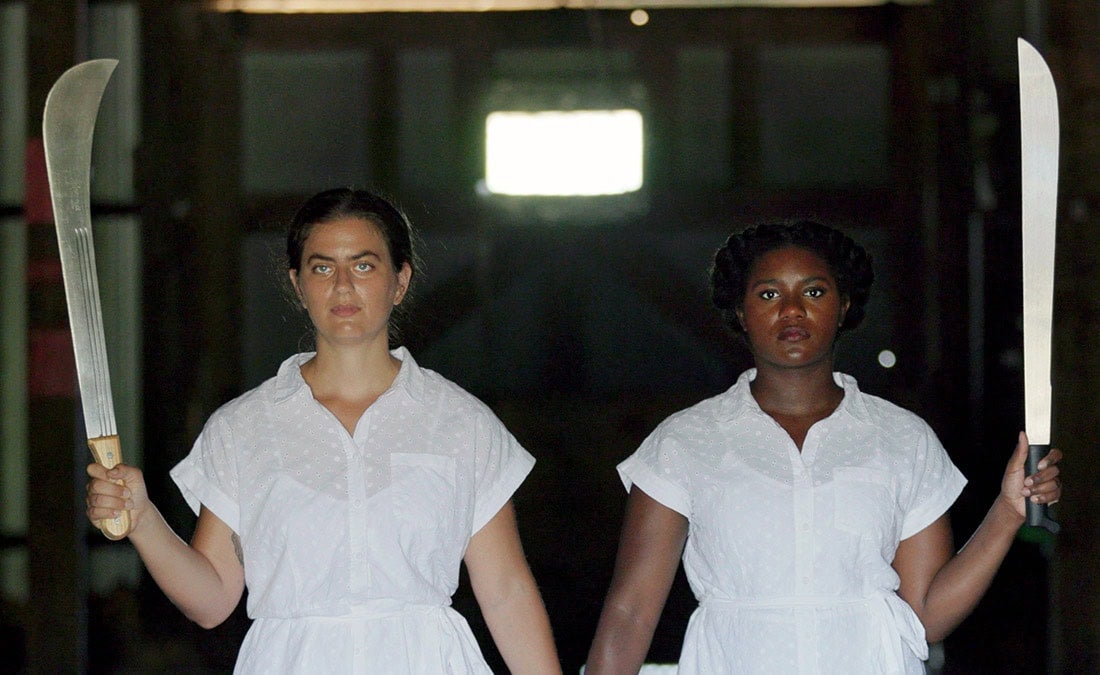
Christine Wyatt and Christina Leoni-Osion in production still from Entre Puerto Rico y Richmond: Women in Resistance Shall not be Moved, 2020 by Alicia Díaz, co- created with Patricia Herrera, Christine Wyatt, Christina Leoni-Osion, Luis Vasquez La Roche, Héctor “Coco” Barez, Yaraní del Valle, and David Riley. All images courtesy of the Institute of Contemporary Art at Virginia Commonwealth University, Richmond.
VCU’s contentious recent history doesn’t necessarily invalidate the intention or impact of Commonwealth, but it frames the institution and exhibition within a web of paradoxes that characterize our modern world and which we all must navigate. In a way, this is the very premise of the exhibition. A joint project of the ICA, Philadelphia Contemporary, and Beta-Local in San Juan, Puerto Rico, Commonwealth mines the innate discrepancy of its title: the power and utopian promise of “common wealth” versus the actual colonialism and inequity entrenched in the past and present of each venue’s city. Originally planned as an exhibition presented in different capacities in all three designated commonwealth territories, the pandemic ultimately restricted the physical exhibition of newly commissioned works to the ICA (which the curatorial team takes care to note is built on stolen Powhatan land). Along with an extensive lineup of related programming, Beta-Local has overseen a bilingual publication that will be released serially, both in print and digitally, over the course of the fall, while Philadelphia Contemporary has developed a neighborhood regranting program and banner project in its city.
For a project so geographically widespread and conceptually ambitious, the physical exhibition is limited to a relatively modest selection of artworks that probe various facets of commonwealth status without overwhelming the space. The indoor gallery is largely populated by three video installations. Two of these combine documented choreography and sculptural elements installed alongside the videos to confront colonial histories, including occupation of indigenous lands (in a video by Tanya Lukin Linklater) and the overlapping tobacco industries that have shaped both Virginia and Puerto Rico (in a video by Alicia Díaz). In the third film, Ricerche: two, artist Sharon Hayes interviewed two Dallas-area women’s tackle football teams as the players huddled together and took turns candidly reflecting on life as athletes. The piece’s panoramic, concave screen pulls the viewer into the group and creates a feeling of intimacy. Because the players’ athleticism on the field is immediately read as a contradiction of gender roles, the work is also inherently political. The players’ perspectives, personalities, and gender expressions are in no way homogenous; they are a team, not a monolith—an important distinction that must be made about every community represented in the exhibition.
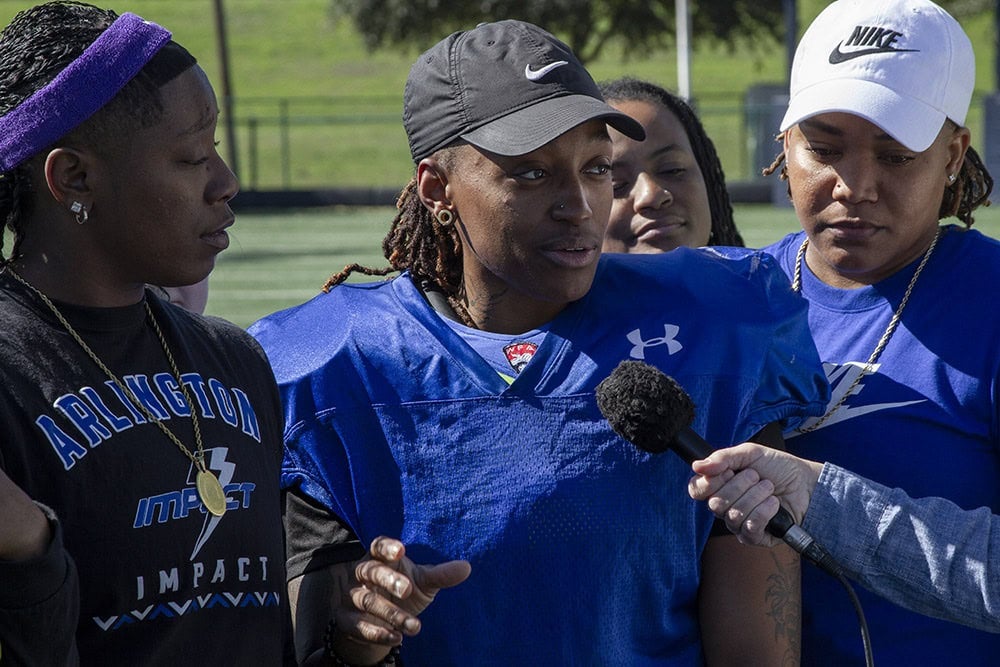
Production still from Ricerche: two by Sharon Hayes, 2020. Left to right: Ken Gabriel, Luckey Townson, Kim Rose, Deezy Ricks. Photo by Rolando Sepulveda II.
In addition to the video installations, the indoor gallery includes hanging textile panels by Carolina Caycedo. Titled Distressed Debt, these five sheer banners are printed with collages of archival documents from Virginia, Pennsylvania, and Puerto Rico associated with historically destructive public utility bonds. Despite the banality of its elements, the colorful hodgepodge of state letterhead, currency embellishments, and decorative stamps makes for a deceptively inviting centerpiece in the gallery. One panel bears the slogan, If you think the charm of Puerto Rico is unique, let us tell you about the bonds of Puerto Rico, as if the commonwealth’s financial strife were a tourist attraction. According to the adjacent wall text, Caycedo was interested in the way the deterioration of physical currency mirrors Puerto Rico’s economic crisis. But the discordant commercial polish unifying the panels seems more like a sardonic conflation of the commonwealth’s public image and its far less ideal reality—Puerto Rico has a bond debt fifteen times those of mainland states. Since the “commonwealth” designation has been used to obscure the fact that Puerto Rico remains a colony of the United States, the contradictions of this label are especially fraught.
Though the art world has sustained incalculable damage as a result of pandemic shutdowns, the creative charge for museums and galleries to literally turn themselves inside out has, in some cases, brought art directly to communities too often alienated by gallery walls. The curators of Commonwealth made equal use of the ICA’s outdoor space and indoor galleries—a necessary design in pandemic days, and one that supports the exhibition’s community-minded ethos. The work not only spills out onto the busy corner of Broad and Belvidere through Chavis’s Resiliency Garden, it also climbs up the building’s exterior in the form of two murals. Though understated compared to Firelei Báez’s dramatic, billboard-scale mural personifying revolution as a female deity emerging from an ocean wave, Monica Rodriguez’s wraparound mural of monuments to Caribbean independence movements is no less compelling.
Also presented outdoors is a recurring live performance conceived by Puerto Rico-based artist Nelson Rivera. For El Maestro 4, the artist enlists non-Spanish-speaking Americans to read speech excerpts from Puerto Rican independence movement leader Pedro Albizu Campos—in Spanish, into a megaphone. In the inaugural performance, the speaker’s thick American accents and inelegant delivery made abundantly clear that the volunteer readers are meant to be anything but “maestros” (unlike Albizu Campos, who, by the way, spoke eight languages). The humor and vulnerability in the performance collapse the tension and violence that American English-speakers inflict on language differences. At the same time, the interpretation of the text by non-Spanish speakers distills the political proclamations to the intrinsically abstract expressions that all words really are. Though an ephemeral and ostensibly simple gesture, Rivera’s contribution to Commonwealth is the exhibition’s most powerful play on incongruity. During a virtual panel discussion hosted by the ICA, Rivera noted that the incendiary speeches included in his score put Albizu Campos in prison. “If it’s a crime to say those things,” he added, “we should all commit that crime.”
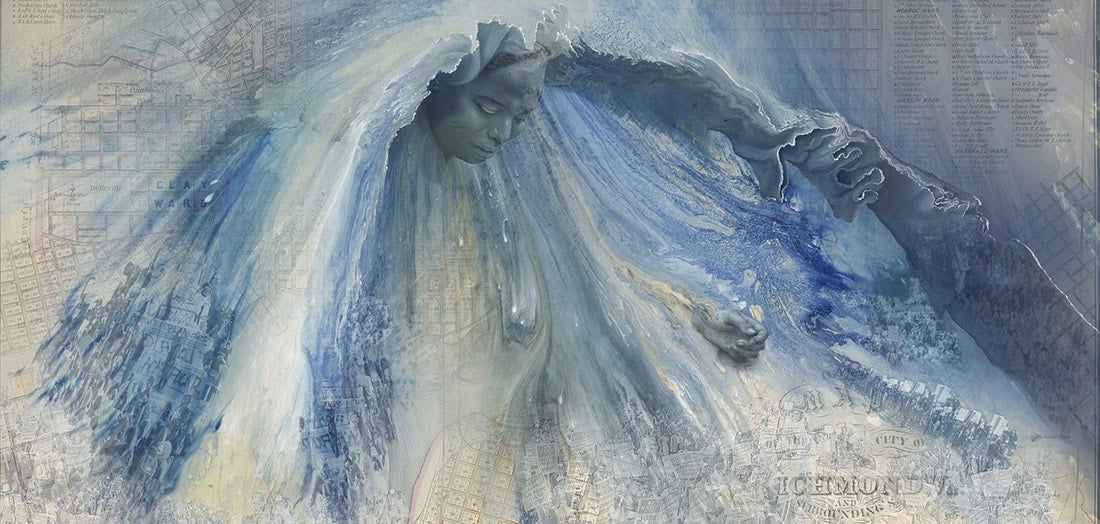
Firelei Báez, Moon minded the sun goes farther (to the Daughters of Revolutions, who could fly between the Artibonite and the James River), 2020. Courtesy of the artist and James Cohan, New York.
Not far from the ICA, collective action converges at the focal point of Richmond’s Monument Avenue and the city’s recent protests. Here, a thirteen-ton monument to confederate general Robert E. Lee towers over what is now referred to as Marcus-David Peters Circle, in honor of an unarmed man killed by police in Richmond in 2018. The massive pedestal is now encircled by miniature memorials to Black lives lost to police violence and coated in vivid graffiti demanding justice. Just feet away, a community garden grows fresh produce, with essential items left in a box nearby for those in need. Activists host monthly music performances and continue to organize demonstrations. A pair of basketball hoops and a picnic table overflowing with food donations encourages gathering and exchange. Sometimes, a volunteer will cook up hot food. While Richmond has uprooted many confederate memorials since the protests began, the Lee monument’s pending removal has been delayed by a legal battle as of this writing. In the meantime, activists have reclaimed the space, here at the epicenter of the former capital of the Confederacy, built on occupied Indigenous ground. While the ICA has attempted to create vital space for artists and viewers alike to challenge inequity and envision truly “common wealth,” at Marcus-David Peters Circle, a consciously paradoxical site of both historical atrocity and an ongoing struggle for justice, activists are making it a reality.
Desde el inicio, Commonwealth—una exhibición grupal en el Instituto de Arte Contemporáneo de la Universidad Commonwealth en Richmond—es un ejercicio basado en la contradicción. En las afueras de la entrada del edificio, un jardín urbano espacioso, creado por el activista de justicia alimenticia Duron Chavis y el diseñador Quilian Riano, celebra la vida Negra y la necesidad de espacios inclusivos mediante huertos cubiertos por imágenes y citas de Assata Shakur, Audre Lorde y otros activistas e intelectuales Negros. Un mural colindante, que cubre tanto una pared como el pavimento que la acompaña, declara EL ESPACIO NEGRO IMPORTA, haciéndole eco a los murales callejeros que este verano aparecieron en ciudades por todo el país. A esto se le añade que, un poco más allá del jardín, una franja de grafiti cubre el exterior en titanio del edificio. A pesar de los intentos de remover la escritura, persiste la visibilidad de los mensajes: BLM (Black Lives Matter o Las vidas negras importan), Pal Carajo 12, Pal Carajo VCU (Virginia Commonwealth University o Universidad Commonwealth de Virginia) y A VCU no le importa BLM. Al lado de estos mensajes, un par de cámaras de seguridad vigilan el área. Las aseveraciones conflictivas y contradictorias que encontramos aquí son notables: por una parte, tenemos una admirable intervención artística, comisionada por una institución poderosa, que está reconociendo las disparidades sistémicas y corroyendo la inseguridad alimenticia (los frutos cultivados en el jardín son donados a la dispensa de alimentos del recinto que está destinada a los estudiantes más necesitados); por otra parte, hallamos una condena de esa misma institución por su fracaso a la hora de reflejar esos mismos valores.
El grafiti apareció durante las protestas que explotaron en Richmond tras los asesinatos de George Floyd y Breonna Taylor cometidos por la policía. También evidencian la crítica que la universidad ha tenido que enfrentar tras la reacción del presidente universitario a la revuelta popular. En julio, un día después que la policía tirara gas pimienta contra los activistas que protestaban y que arrestaran a varios manifestantes—incluyendo estudiantes de VCU y miembros del Gobierno Estudiantil Asociado (SGA) de VCU—el presidente de la universidad, Michael Rao, presentó una declaración pública denunciando que supuestamente VCU había sufrido $100,000 en daños a la propiedad durante el momento de ebullición de las protestas, mientras simultáneamente expresaba su solidaridad con la causa. SGA rápidamente respondió a la declaración diciendo que la universidad “le daba prioridad a la ganancia y la imagen por encima del bienestar de los estudiantes.” Las declaraciones inconsistentes del presidente Rao sobre su solidaridad y la insinuación del miedo que supuestamente le causaban los manifestantes se vio reflejado en las calles de Richmond: muchas de las vitrinas de los negocios en el distrito comercial están sellados tanto por madera contrachapada, como por carteles que leen Las vidas negras importan.
El historial contencioso y reciente de VCU no necesariamente invalida la intención o el impacto de Commonwealth, pero sí enmarca la institución y la exhibición dentro de una red de paradojas que caracterizan nuestro mundo moderno y que todxs tenemos que navegar. De cierta manera, esta es la premisa de la exhibición. Commonwealth, un proyecto conjunto del ICA, Philadelphia Contemporary y Beta-Local en San Juan, Puerto Rico, mina la innata discrepancia de su título: el poder y la promesa utópica de un “common wealth” o “riqueza común”, versus el colonialismo y la inequidad atrincherados en el pasado y presente de la ciudad donde se sitúa cada local. La exhibición originalmente se iba a presentar en diferentes capacidades en los tres territorios designados, pero la pandemia eventualmente restringió la exhibición física de los nuevos trabajos comisionados por el ICA (que, como notó el equipo editorial, está construido sobre tierra Powhatan robada). En adición a una programación relacionada y extensiva, Beta-Local supervisó la creación de una publicación bilingüe que se presentará de forma serial, tanto de forma impresa como digital, durante el transcurso del otoño, mientras que Philadelphia Contemporary ha desarrollado un programa de otorgar financiamientos y un proyecto de pancartas para su ciudad.
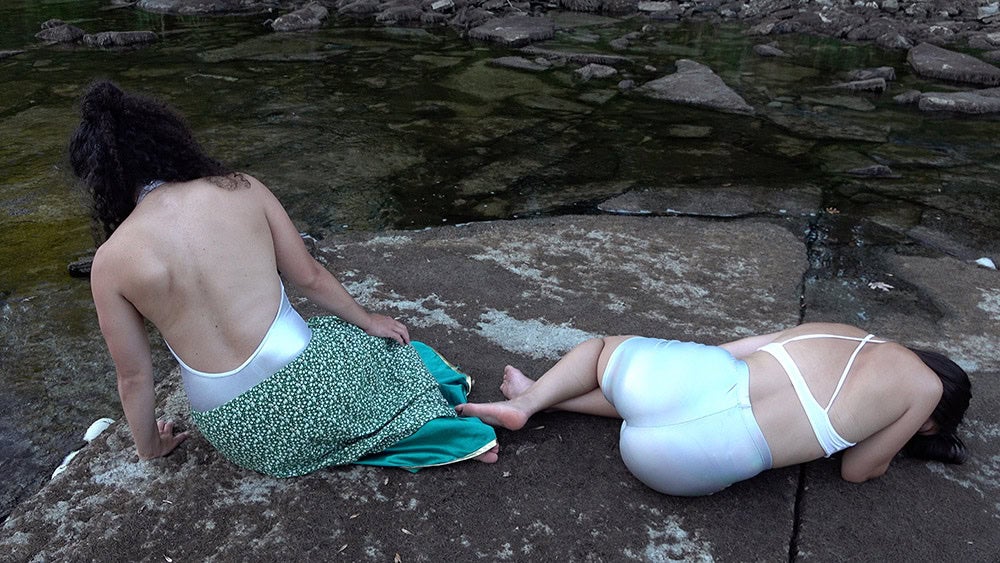
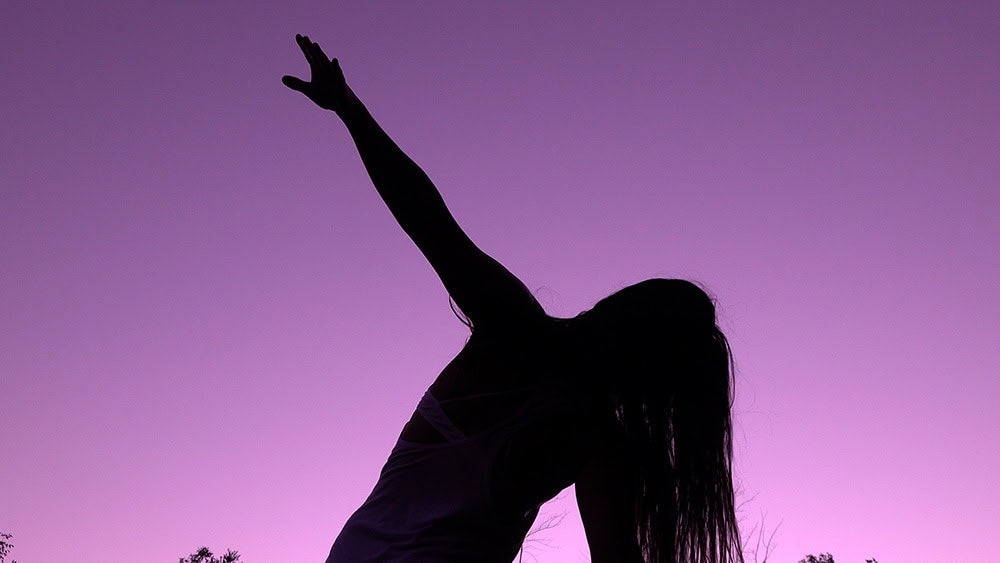
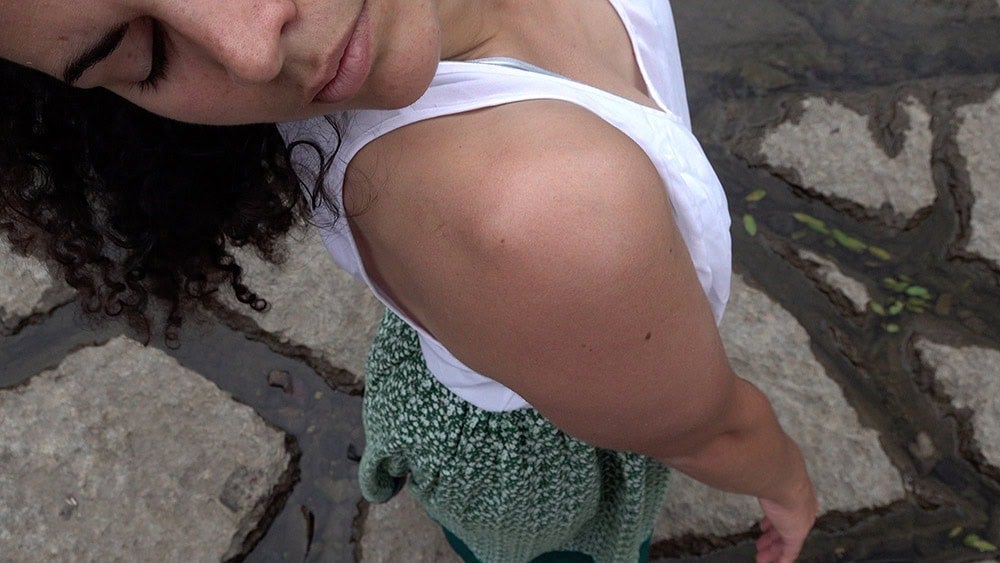
Tanya Lukin Linklater, video stills from This moment an endurance to the end forever, 2020, with performances by Ivanie Aubin- Malo, Ceinwen Gobert and Tanya Lukin Linklater. Camera by Duane Linklater, Neven Lochhead and Eric Robillard.
Para un proyecto tan geográficamente amplio y conceptualmente ambicioso, la exhibición física se limita a una selección modesta de obras que examinan las facetas varias del estatus de “commonwealth” sin abrumar el espacio. La galería a puertas cerradas está principalmente poblada por tres instalaciones de video. Dos de estas combinan coreografía documentada y elementos escultóricos que están instalados para acompañar a los videos en sus enfrentamientos a los múltiples historiales coloniales, incluyendo la ocupación de terrenos indígenas (en un video de Tanya Lukin Linklater) y las industrias tabacaleras solapadas que han formado tanto a Virginia como a Puerto Rico (en un vídeo de Alicia Díaz). En tercer filme, Ricerche: two, la artista Sharon Hayes entrevista a dos equipos femeninos de futbol americano de atajo que están ubicados en el área de Dallas mientras las jugadoras se agrupan en un huddle y toman turnos reflexionando cándidamente sobre sus vidas como atletas. La pantalla panorámica y cóncava de la pieza jala e integra el espectador al grupo y crea un ambiente íntimo. Como la presencia de las jugadoras en el campo de deportes se lee inmediatamente como una contradicción de los roles de género asignados, el trabajo es también inherentemente político. Las perspectivas, personalidades y expresiones de género de las jugadoras para nada son homogéneas; son un equipo, no un monolito—una distinción que es importante recalcar cuando hablamos sobre cada una de las comunidades representadas en la exhibición.
Además de las instalaciones de video, la galería interior incluye paneles de textiles realizados por Carolina Caycedo. Titulados Distressed Debt (Deuda angustiada) estas pancartas de tela fina están impresas con collages de documentos que provienen de archivos de Virginia, Pensilvania y Puerto Rico, todos asociados con los históricamente destructivos bonos de utilidad pública. A pesar de la banalidad de sus elementos, el colorido sancocho del encabezado oficial del estado, dinero adornado y sellos decorativos le sirven a la galería de pieza central engañosamente acogedora. Un panel lleva el lema, Si crees que el encanto de Puerto Rico es único, deja que te hablemos sobre los bonos de Puerto Rico, como si la lucha financiera del archipiélago fuese una atracción turística. Según el texto que acompaña la pieza, a Caycedo le interesaba la forma en que el deterioro físico del dinero refleja la crisis económica de Puerto Rico. Pero el esmalte comercial discordante que unifica los paneles parece más una fusión sardónica de la imagen pública del Estado Libre Asociado y menos una realidad idónea—Puerto Rico tiene una deuda de bonos quince veces más grande que la de cualquier estado. Como la designación “commonwealth” se ha utilizado para obscurecer el hecho de que Puerto Rico sigue siendo una colonia de los Estados Unidos, las contradicciones de esta etiqueta están particularmente cargadas.
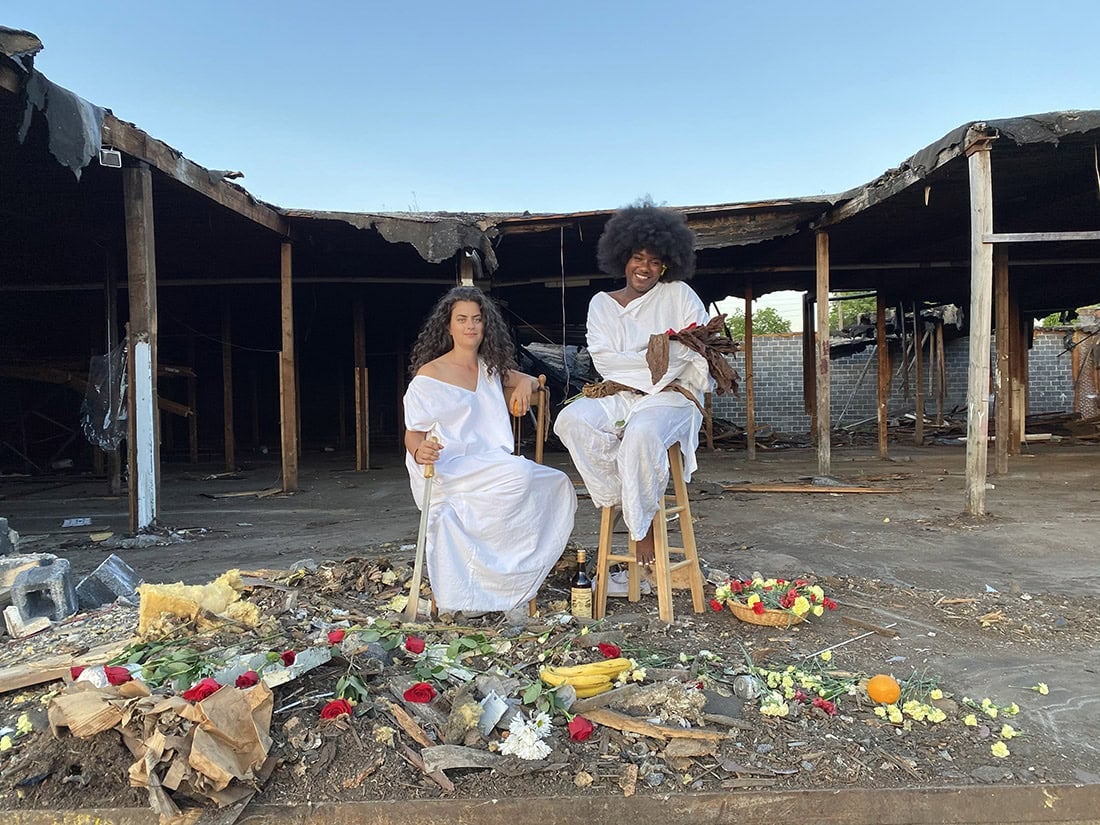
Christine Wyatt and Christina Leoni-Osion in production still from Entre Puerto Rico y Richmond: Women in Resistance Shall not be Moved, 2020 by Alicia Díaz, co- created with Patricia Herrera, Christine Wyatt, Christina Leoni-Osion, Luis Vasquez La Roche, Héctor “Coco” Barez, Yaraní del Valle, and David Riley. Photo by Luis Vasquez La Roche.
Aunque el mundo del arte sostuvo un daño incalculable como resultado de los cierres ocasionados por la pandemia, el impulso creativo para que los museos y las galerías literalmente se vuelquen de adentro hacia afuera, en algunos casos, ha traído el arte directamente a comunidades que con demasiada frecuencia se habían visto alienadas por las paredes de las galerías. Los curadores de Commonwealth utilizaron los espacios exteriores y las galerías interiores del ICA de forma equitativa —un diseño necesario en tiempos pandémicos, y uno que apoya los valores comunitarios de Commonwealth. El trabajo de los artistas no solo se desbordó sobre la esquina ocupada de Broad y Belvidere, con el Resiliency Garden (El jardín de la resiliencia) de Chavis, sino que subió por el exterior del edificio con dos murales. Aunque es sobrio en comparación al mural dramático de Firelei Baez, que ocupa el tamaño de una cartelera y personifica la revolución como una deidad femenina emergiendo de una ola, el mural de Mónica Rodríguez, que envuelve el edificio y es un monumento a los movimientos de independencia en el Caribe, no es menos conmovedor.
En el espacio exterior también se presentó en vivo la pieza performática recurrente concebida por Nelson Rivera. Para El Maestro 4, el artista invita a estadounidenses que no son hispanoparlantes a leer selecciones de discursos del líder independentista Pedro Albizu Campos—en español, con un altoparlante. En la iteración inaugural de la pieza, los acentos fuertes de los estadounidenses y la lectura poco elegante dejó claro que los lectores voluntarios eran lo opuesto a “maestros” (a diferencia de Albizu, que, de hecho, hablaba ocho idiomas). El humor y la vulnerabilidad de la pieza colapsan la tensión y la violencia que los estadounidenses angloparlantes infligen sobre las diferencias lingüísticas. A la vez, la interpretación del texto por los no-hispanoparlantes destila las proclamaciones políticas en las expresiones intrínsecamente abstractas que son el carácter real de las palabras. Aunque sea un gesto efímero y ostensiblemente simple, la contribución de Rivera a Commonwealth es el juego sobre la incongruencia conceptual más potente de la exhibición. Durante una discusión virtual auspiciada por el ICA, Rivera notó que los discursos incendiarios que incluyó en su pieza fueron los que llevaron a la encarcelación de Albizu Campos. Añadió que “si es un delito decir esas cosas, todos deberíamos cometer ese delito.”
Cerca al ICA, la acción colectiva converge en el punto focal de la Avenida Monument y las protestas que se han dado recientemente en la ciudad. Aquí, un monumento de trece toneladas dedicado al general confederado Robert E. Lee domina lo que ahora se conoce como Marcus-David Peters Circle, en honor al hombre no armado que fue asesinado por la policía en el 2018. El pedestal masivo hoy está cercado por memoriales en miniatura dedicados a las vidas Negras destruidas por la violencia policiaca y cubierto por grafiti vívido que demanda justicia. A unos pies, cultivos frescos crecen en el jardín comunitario y una caja cercana contiene artículos esenciales para los más necesitados. Los activistas organizan funciones musicales y continúan organizando protestas. Un par de aros de baloncesto y una mesa de picnic colmada de donaciones alimenticias invitan al encuentro y al intercambio. A veces, un voluntario prepara comida caliente. Aunque Richmond ha extirpado muchos memoriales confederados desde que comenzaron las protestas, el monumento de Lee no ha sido removido debido a una batalla legal que sigue pendiente. Mientras tanto, los activistas han reclamado el espacio, aquí en el epicentro de la antigua capital de la Confederación, construida sobre tierras indígenas que fueron ocupadas. Mientras que el ICA sigue intentando crear un espacio vital para que tanto los artistas como los espectadores puedan retar la inequidad y realmente imaginarse una “riqueza común”, en Marcus-David Peters Circle, un conscientemente paradójico espacio de atrocidad histórica y una lucha continua por la justicia, los activistas están realizando ese sueño.
Commonwealth is on view at the Institute for Contemporary Art at Virginia Commonwealth University through January 17, 2021.
Commonwealth está a la vista en el Instituto de Arte Contemporáneo de la Virginia Commonwealth University hasta el 17 de enero de 2021




